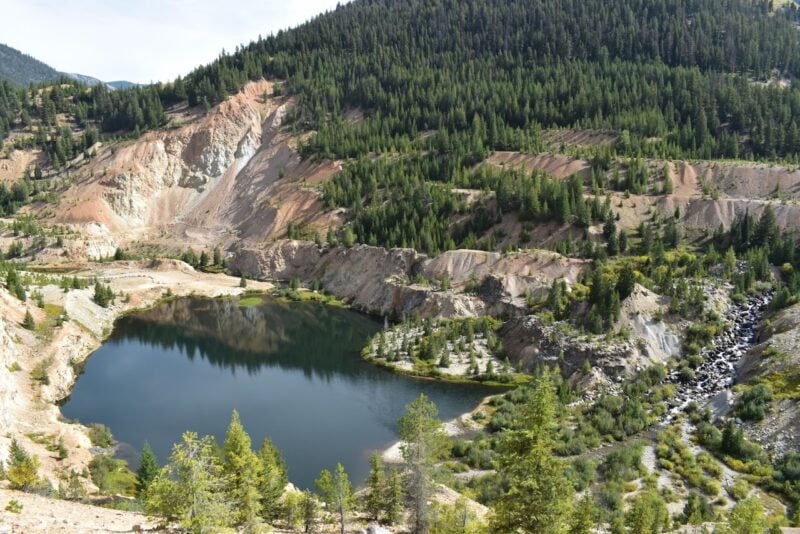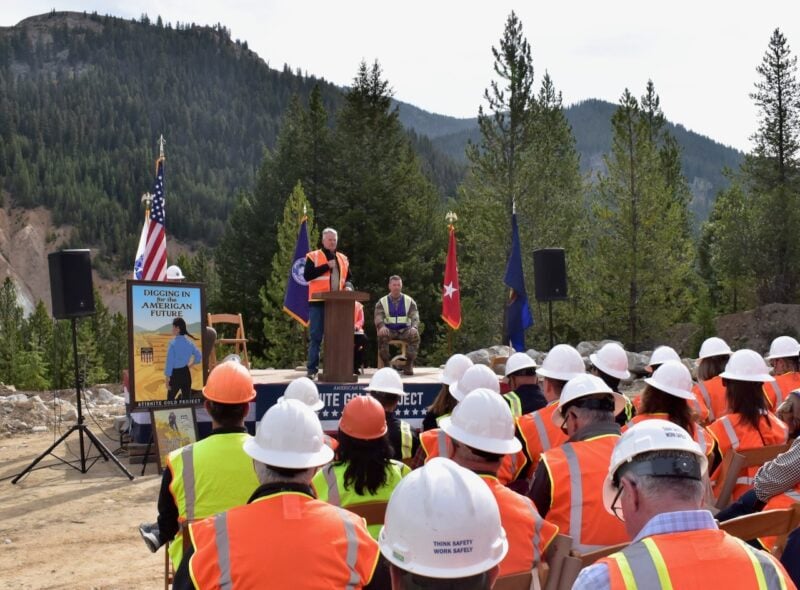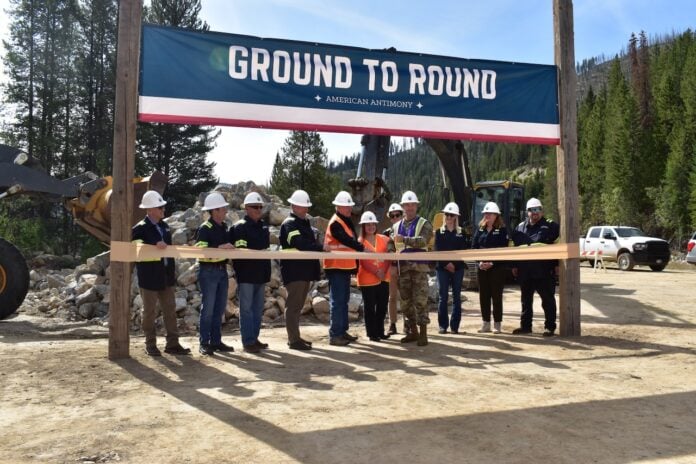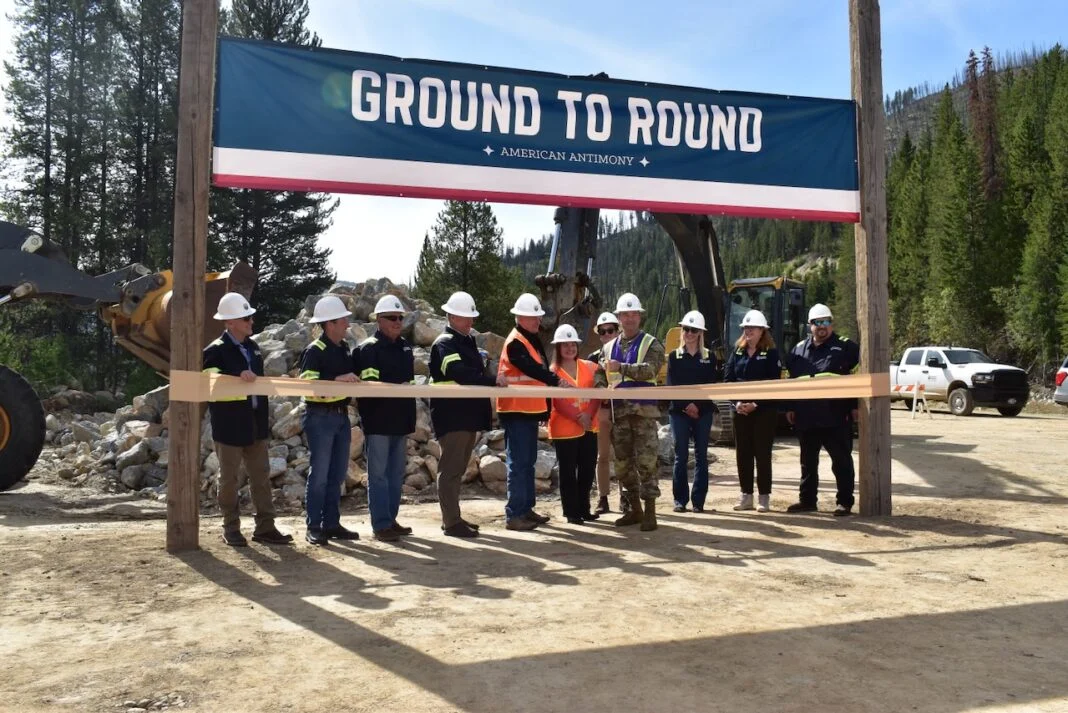Work to build a gold and antimony mine in eastern Valley County is officially underway.
Perpetua Resources received final approval this week to begin construction on its Stibnite mine, located about 40 air miles east of McCall, after meeting the terms of the Forest Service’s initial approval earlier this year.
A groundbreaking ceremony was held at Stibnite on Friday afternoon, with remarks from Perpetua CEO Jon Cherry, Gov. Brad Little, and U.S. Army Major General John Reim.
Cherry told Valley Lookout after the ceremony that the company will begin preliminary construction work in October.
“We’re calling this our early works package,” he said. “We’ll be working on roads, power, camp, detailed engineering, and placing orders for some long lead-time equipment.”
Cherry expects to finalize a $2 billion construction loan this winter so that the company can begin major construction next year. Among the first components of the mine to be built will be a mile-long tunnel that will divert the East Fork South Fork Salmon River around the existing Yellow Pine Pit Lake, one of three open-pit mines included in the project.
“We’re designing it so that fish can (pass) through the tunnel,” Cherry said. “They can’t get past the pit right now.”
Overall, construction is expected to take about three years to complete. Then, Perpetua expects to spend 12 to 15 years extracting 4.8 million ounces of gold and 150 million pounds of antimony from its three pit mines.
Among the final hurdles Perpetua was required to clear before beginning construction was a financial agreement guaranteeing site clean-up work is funded after mining. That amount has been set at $155 million, but Cherry said the specifics of the financing are still being determined.

Antimony focus
Although nearly all the economic value of the Stibnite mine is tied to gold, much of the focus in recent years has been on antimony, which continued to dominate the conversation at Friday’s ceremony. A ribbon-cutting photo opportunity was even staged in front of a pile of antimony ore.
The Stibnite mine is set to become the only domestic source of antimony, which is used in military munitions, batteries, computer chips, and a host of other products.
China, Russia, and Tajikistan produced about 79% of all mined antimony in 2023, according to data from the U.S. Geological Survey. China, the world’s leading antimony producer, banned exports of the mineral to the United States in December.
Without donors like you, this story would not exist.
Make a donation of any size here
Reim called the mine’s approval a “significant milestone” in strengthening national security.
“For too long, we’ve relied on foreign sources for critical minerals essential to our national defense,” Reim said. “This project is not just about striking gold, it is also about strategic independence.”
Since 2022, Perpetua has received more than $80 million in funding from the Department of War, including nearly $60 million to cover general expenses of the mine.
The funding has also contributed to studies of the antimony at Stibnite to confirm it can be processed to military grade specifications. A pilot processing plant is currently under construction.
“We anticipate the start of raw antimony sulfide production in late 2028,” Reim said.
Gov. Brad Little credited President Donald Trump’s administration for naming Stibnite a “priority project” earlier this year, as Valley Lookout reported, and expressed the importance of the domestic industry.
“Over time, by small increments we took what is critical to defend this country and moved it offshore,” Little said. “This project is definitive proof of what we need to do to defend this country.”

Shareholder influence
Perpetua’s focus on antimony began after Paulson & Co., a New York City investment firm, became the company’s largest shareholder in 2020 and orchestrated a takeover of the corporate board.
The firm, led by billionaire John Paulson, has invested $185 million since 2016 in Perpetua, which was known as Midas Gold before the leadership change. Paulson owns more than 32 million shares of Perpetua stock, which is good for a 31% ownership stake.
Paulson attended Friday’s ceremony at Stibnite, but did not speak. The ceremony was also attended by Marcelo Kim, a Paulson partner who chairs Perpetua’s corporate board.
The ceremony also included the presentation of a $350,000 check to the Stibnite Foundation, which was established by the company in 2019 to fund community projects.
The $350,000 check, promised years ago upon the start of construction, nearly doubles the $400,000 Perpetua had contributed to the foundation so far, in addition to 150,000 shares of the company’s stock.
“Today isn’t just about our next steps as a company,” Cherry said. “It’s about keeping promises—promises to our communities, our partners, to Idaho’s future and the defense of our nation.”
Project background
Perpetua plans to extract more than $6 billion in gold, silver, and antimony from Stibnite, which was the site of historic mining operations during World War II and as far back as 1899. The permitting process for the mine cost Perpetua more than $400 million.
The metals would be extracted from three open-pit mines totaling about 473 acres within the 1,740-acre project zone, which is about three miles from the Frank Church – River of No Return Wilderness.
Opponents of the mine fear it could pollute the East Fork South Fork Salmon River, which flows through the project site, and cause other environmental damage.
Water quality in the East Fork and other streams at the proposed mine site does not currently meet federal drinking water standards due to high concentrations of arsenic and antimony from pollutants left by previous mining companies.
Perpetua’s mining proposal is authorized by the General Mining Act of 1872, a federal law that allows anyone to patent mining claims on public land.
A review of the project began in 2016 under the National Environmental Policy Act, a federal law that requires all projects that could affect natural resources to be studied for environmental harm.
An approval issued earlier this year by the Forest Service is currently subject to separate lawsuits filed by conservation groups and the Nez Perce Tribe.






